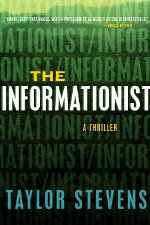Special thanks to Taylor Stevens, Paula Berinstein and Kim Urig for making this interview happen!
Cut off from personal family, at times under the care of sadistic individuals and without access to books or television from the outside world, imagination became a survival mechanism. As a young teenager, I secretly entertained commune children with fantastic stories that took us through time and space, until these sins were discovered by cult leaders. Several laboriously hand-written books were confiscated and burned and I was ordered on pain of–well, a whole lot of pain–never to write again.
The nomadic culture of the cult became an adolescent’s journey across four continents and nearly two dozen countries culminating in four years living in East and West-Central Africa–this the primary setting for THE INFORMATIONIST.
Along this journey I have seen the best and worst of humanity and don’t have to look far to find the depth of soul and tormented conflict that drives my characters; I pull heavily from personal experience and the experience of the ones I love when creating the worlds they walk in.
I was in my twenties when I broke free, and leaving everything I knew brought with the fear, a fresh beginning. Refusing to go to my grave with regrets, “what ifs,” or tears over the lost years, I set out to take back what was taken from me. Through trial and error and observing the masters I taught myself the craft, and gradually the gift of storytelling returned. Learning basics that many take for granted has been a journey to be sure, but on the flip side, if I ever need to make breakfast for 150 people, I’ve already got that covered.
The focus of our interview will be Taylor’s debut novel, The Informationist, published by Crown and available now.
The Informationist is the story of Vanessa “Michael” Munroe, who is an informationist, a job that takes her all over the world gathering information for corporations, governments and other private clients. Her latest assignment is to find a wealthy oil tycoon’s daughter, who disappeared in Africa four years ago.
I’m not well-versed in the thriller genre, but I do know a thrilling book when I read one. The Informationist kept me awake past my bedtime on quite a few occasions. Each time I opened it, I felt like I was swept into Africa. If I hadn’t had a deadline for this interview, on page 267 I would’ve slowed down just a bit to savor it. Then again, I may not have been able to help myself and gobbled it up anyway. It’s that good and compelling a read.
I’m eagerly anticipating the second installment in Munroe’s story, with the working title of The Innocent, due out next year. It was a pleasure and an honor to talk with Taylor Stevens, and you can listen to our conversation below. You can click the link and listen with a program like Windows Media Player, or download it to an iPod or other MP3 player. Enjoy!


